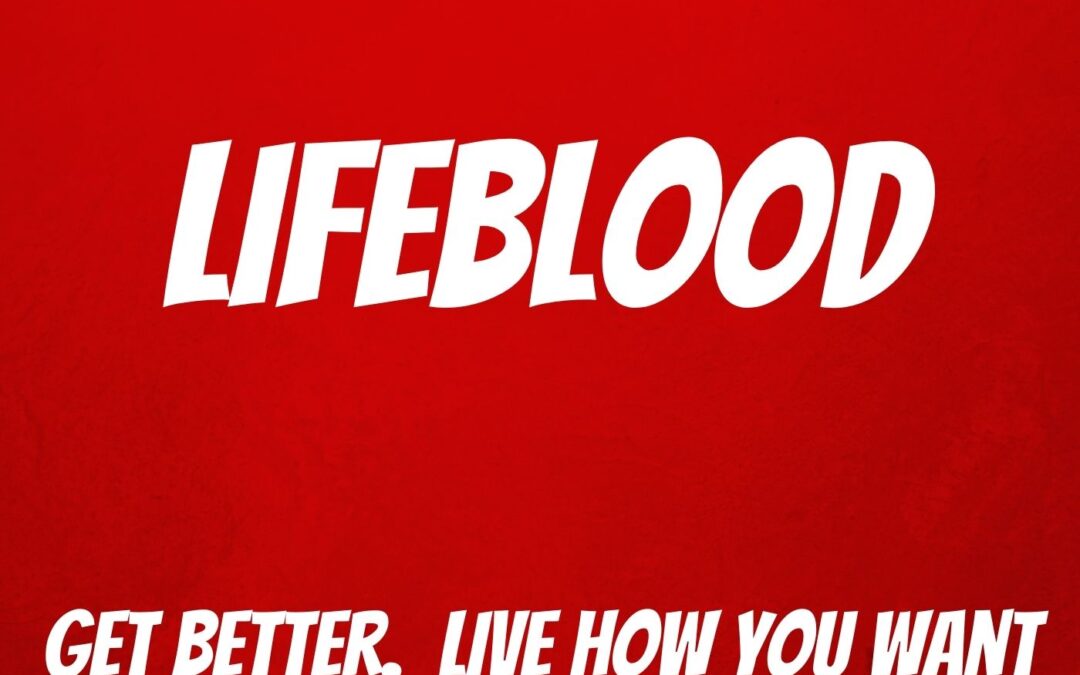Know your Worth with Robin Waite
Are you charging what you’re worth for the work you do? Robin Waite talks about how far too many of us undercharge because of fear of rejection and shares an actionable process for breaking through and earning what you’re worth!
About the Episode
LifeBlood: We talked about how to know your worth, why it’s a mistake to charge by the hour, what stops people from chagrin what they’re worth, and how to break through blocks and start making the money you want with Robin Waite, Founder of Fearless Business, speaker, podcaster, best-selling author and coach.
Listen to learn why you’re taking too long to decide on what you’re working go create and how to get started now!
For the Difference Making Tip, scan ahead to 19:13!
You can learn more about Robin at Fearless.Biz, RobinWaite.com, Facebook, Twitter, Instagram and LinkedIn.
Thanks, as always for listening! If you got some value and enjoyed the show, please leave us a review wherever you listen and subscribe as well.
You can learn more about us at MoneyAlignmentAcademy.com, Twitter, LinkedIn, Instagram, Pinterest, YouTube and Facebook or you’d like to be a guest on the show, contact George at Contact@GeorgeGrombacher.com.

George Grombacher
Lifeblood Host

Robin Waite
Guest
Episode Transcript
george grombacher 0:00
Come on. Welcome to life blood. This is George G. And the time is right to welcome today’s guests a strong and powerful Robin. Wait, Robin, are you ready to do this?
Robin Waite 0:19
Absolutely. 100% George, let’s do it.
Unknown Speaker 0:21
Let’s let’s let’s go. Robin is the founder of fearless business. He’s a speaker, a podcast host, a best selling author of five books excited to have you on. Robin, tell us a little about your personal life more about your work and why you do what you do.
Unknown Speaker 0:36
Yeah, well, I suppose the business side of things. For me, it’s a bit of a side hustle because I’m a dedicated husband and I have seven and five year old daughters who properly keep me on my toes. So So yeah, the business actually comes second to them at all times. And they’re at that point where they’re doing all of the holiday clubs and, you know, weekend clubs and things like that. So we’re busy just moving them around all the time. But yeah, and then after the business I serve as well. I’m a keen cyclist, one of those annoying like reclad weekend warriors holding up all the traffic. That’s me doing my bits in general.
Unknown Speaker 1:10
And tell us a little bit about the work.
Unknown Speaker 1:13
So yeah, the fearless business. So we were a coaching practice. And, and I like to think that we have some some, you know, very unique qualities, but so, so we work with other coaches and consultants typically time for money based businesses and help them to productize whatever it is that they’re selling. Typically, when you productize something, it means that it’s worth a lot more. So our focus is on helping people, people, our clients to articulate their value better so that they can increase their prices. And obviously, that that then has, you know, this is where we start to make a real impact. Because when you charge more and you make a bit more profit, then obviously you can reinvest that money back into the business make more and or you can have a lot more sort of fun with your family and things like that. So I think I’ve calculated over the last five years with fearless business, we’ve had eight fearless babies, not all mine, obviously client one. We’ve had several who’ve been able to save up and buy house, we’ve had several who have gone on to move out of their home office and get a proper big office, we’ve also had several where one of the partners husband and wife, husband husband, one of them has been able to give up their day job and come into the business as well. So for me, those are like the real impacts that we like to make it feels business. I love
Unknown Speaker 2:25
it, help people create a virtuous cycle versus a vicious cycle that if we are not charging enough, or what we’re worth, that you’re sort of trapped in
Unknown Speaker 2:36
100% and I think people people forget that, that kind of one objective with businesses to make make money. Okay, you know, it’s not beat about the bush. But the reality is you can do that there is always a reason why we want to earn money so as to have a better life in some way, shape, or form, or to do do some kind of good. But and the reason I always kind of caveat, this is like, yes, the one goal is to make money is to make profit. But you can do that with a sense of like passion, purpose, vision, mission values, like all of that good stuff as well, and run a very ethical and sustainable business in the same time as making a shit ton of cash.
Unknown Speaker 3:13
Nice. I appreciate that. So how often, it’s probably tough to quantify are people not charging enough?
Unknown Speaker 3:24
Well, pretty much every business owner who is charging time for money. So either an hourly rate or day rate is in some way under selling themselves. And the reason the reason for that is because when you know typical mistakes, which I see people make so especially if they’re charging hourly rates, they’ll be told by all the experts and gurus going do your competitor research go and see what the competition are charging. Now that’s good. I always say, you know, I’m not knocking that go look at the competition, but the mistake is the assumption that your competitors know what they’re doing. So if George is looking at Dave, he’s looking at treasured prices. He’s looking at Sharon’s prices. And Sharon’s looking back at George’s prices. I’m like, which one of you four is the expert in pricing? And the answer is probably none of you. Okay. So, you know, it might be that, you know, we look at George’s prices for comparison, but George actually isn’t making any money. So why would we copy a business model that is fundamentally flawed and not profitable? So there’s, that’s the point where I encourage people to Yes, go and look at the competition, see what everybody else is charging. But remember, there’s probably one person out there and let’s, let’s say for example, I don’t know you’re, you run a local web design business, right? And you look at 20 other web designers in the local area, see what they’re charging. There’s always one who is the most expensive on the market, but they’ve probably been around for the longest, they probably have the greatest the best reputation. They’ve got the most Google review, for example. They’ve got a fantastic website, but the clue is that they’re the most expensive and they’re still able to acquire clients. So there are still people who want to work with them, despite the fact that they’re the most expensive in the marketplace. The likelihood is Well, they’re probably the most profitable, they have the most sustainable business because they’ve been around for the longest, and everybody trusts them. And there’s lots of referral referrals going around for that business. So it is, it is okay to go out there and be the most expensive. And the second mistake is that, if I’m selling an hour of my time, that’s how much I value my time adds, that could be different to how much somebody else values. Okay. And so what I mean by that is there are two other areas of how you should, you know, cost out whatever products or services you’re selling. So we’ve got time, that’s the first one. The second area is overheads and costs, it costs something to run a business. So you need to make sure that time and overheads are included within this. And then the third thing is intellectual property. So, you know, imagine I’ll try and keep this brief because I know we only have a short time to record. But imagine, like sticking with the web design side of things, for example, and I know that because I got to know it. Well, because I ran an agency for 12 years now. It’s predominately one of our services. So imagine we had three different web designers, okay. And so Dave comes along, and he’s charging 50 bucks an hour. And he says, George, it’ll take me 20 hours. So roughly, it’s 1000 $1,000 for this website, either, like, cool, okay. But what George forgot to tell you was that he hasn’t been doing it for very long. He’s not terribly experienced, and his websites, they don’t look great. And they don’t get the best results. Okay, but he comes back three months later, here’s your website, George, and you go, well, hang on, Dave West, where’s the blog and the shopping cart, which he promised me? And so Dave says, I’m sorry about that, George? Well, we’ve used up your 20 hours, it will cost you another 10 hours. Is that cool? You’d be like, why? Hell no, I don’t want to pay any more, we agreed that it would be 20 hours. And that’s what I thought I was paying. So there’s friction straight away. So that’s the first clue that hourly rates just don’t work. Then we have steve steve comes along. He’s been doing this for years. But he doesn’t know what Robin knows about pricing. So he’s also charging 50 bucks an hour. But because he’s really experienced, he can build it quicker. So any takes in 10 hours, and it gets better results, right? And yet, so hang on the guy who is more experienced and gets better results, he only gets paid a third of what you know, Dave, the lesser experienced guys getting paid. So there’s our second clue that it just doesn’t hourly rates just don’t work. Then Trisha comes along, she’s she’s a website Ninja, right, she is the best of the best of the best. And she goes, listen, George, my websites or knock this out the park for you in 24 hours, within 30 days, it will be producing 20 solid leads a month, a month for your business. Okay? My Websites come with a guarantee, if they’re not producing those leads, I’ll pay your pay all of your money back. And I’ll pay you $1,000 of wasting your time, which you can spend with Dave before Steve, is that cool? Sounds great. Excellent. Ask me how much they are? How much that $10,000. But it comes with the guarantee.
Unknown Speaker 7:55
Okay, so you’ve got now a completely different value proposition there which, you know, Tricia has been able to factor in her skills and experience I hear our intellectual property. And all of the case studies, the other websites that she’s built up all of those 20 years worth of experience. You know, she’s an avid learner. So she’s still learning about all the latest and greatest techniques, so and so she’s able to price that into her 10k offer. And yes, on the face of it, it might seem like it’s 10 times the price, but she’s probably offering infinitely more value than the other two are offering at their hourly rates. So, but there is like one really clear reason why people get stuck, and they they don’t want to put crazy rates out. And it’s very simple. fear of rejection, that is the only reason people don’t put their prices up.
Unknown Speaker 8:45
It’s that simple. Basically,
Unknown Speaker 8:47
yeah. But that that fear of rejection is very deep seated. And that’s why it takes a long time to unpack. So if you think about it, I’ve done whether you experienced this, but probably many people listening to this experiences. So between the ages of about three and seven, is when we develop our money blueprint. And if you imagine like if you go, mate, you know, we’re going to regress everybody back to their childhood for a moment here. And probably things which may sound very familiar, are going to be things like, Oh, you can’t have those new sneakers because they’re too expensive. We can’t take a vacation this year because we can’t afford it. Money doesn’t grow on trees. Money is the love of money is the root of all evil if we have to correct myself on that quote to get it right. The love of money is the root of all evil. Oh, look at that Lamborghini. Isn’t that disgusting? Isn’t that grotesque. So people have this very negative, like relationship around money and wealth and things like that. But again, this is where I’d remind people about, you know, the shift here is, without money, we can’t in today’s modern world, we can’t really do much good. So think about all of the charities out there who rely on businesses and individuals to make donations to their good causes. said that we can go and help people who are less fortunate than us. Like money is actually an incredible tool that you can use for good a weapon of good. So for 99% of people who have this really negative attachment to, to money and throughout their youth and going into their sort of LDS, like, we’re always validated by money, it’s like, going for a promotion at work, you know, are, you know, you ask for a pay rise, no, you’re not worth it. Like, those are the things that we keep on hearing, it’s always validated, not worth it. So we’re actually constantly filled with rejection all the way through. And actually, that poor blueprint, money blueprint doesn’t serve us when it comes to being an entrepreneur in business. The entrepreneurs who tend to succeed are the ones that have this deep seated belief that I’m worth it. So if we step out into the workplace, and we’re confident in our value that we can deliver to the world, we’re able to effectively communicate that to prospective buyers. But what it means is, when you charge more, you are going to have fewer clients. So which means like the, you know, the opposite side of that seesaw is that you’re going to get more nose, but you have to be really comfortable with that, like, for every four knows that we get, we only want we only want or need one, yes, if we price ourselves, right to make a decent income, you know, and so, and those numbers are Stark, like, it’s really simple when you break it down. And I know I’ve probably made it sound a little bit sort of, I don’t know, cold. But, but but ultimately, it’s like, get over that fear of rejection, stop being attached to the sale, and you can have a lot more success with your life.
Unknown Speaker 11:34
Yeah, I agree with you 100%. And that we are, for lack of a better term hardwired to have these negative beliefs running. And it’s sort of our operating system. That’s that’s the way that I like to think about it. It sounds easy, but it does hard. Right? So how do I go about breaking that cycle of lack of worth not charging enough?
Unknown Speaker 11:58
So it’s, it’s a three or four stage process? Okay. And actually, it’s, it’s relatively simple. So I tell you what, actually, George, if you if you’re open to playing the game, we can sure you can help me out here. Okay. So think of a product or service that you would love to sell. Okay to it, it can be a course or a program or something.
Unknown Speaker 12:19
Let’s just stick with web design.
Unknown Speaker 12:21
So I stick with web design, right? So let’s say how much would you like to sell? If you had like a, I don’t know, a brochure style website package? How much would you like to sell it for? How much could you think you could get at the moment? $10,000 $10,000. Okay, right. Well, we’re gonna use $10,000 as a starting point, right? Because you’ve already told me Yep, I’d be happy to sell it for 10. But imagine there is a world out there that you could sell that website package for? I don’t know. $50,000. Amazing. So step one is we just saw the seed of an idea. could could we do it? Has somebody ever sold a $50,000? website? Probably. So it’s not beyond the realms of possibility that we can do. So that’s step number one. The second step though, is we’ve got to work out where your level of comfort is. Okay. Because it might be that you go, I mean, you went sure at $50,000. What about $100,000?
Unknown Speaker 13:12
Wow. You know, I bet there are companies that spend that, but I don’t know if I could do that.
Unknown Speaker 13:19
This is now about George, could you sell $100,000? website?
Unknown Speaker 13:22
i? I don’t think so. Okay,
Unknown Speaker 13:26
could you What about? Could you sell a $50,000? One? Yeah, yeah, I
Unknown Speaker 13:30
work.
Unknown Speaker 13:32
Great. So 60,000 70,000 80,000. Okay, so 80,000 was just around about your comfort zone. Okay. Now, everybody probably may be listening to this is going or watching this is going what just happened there, I could actually see there was something in your body language, which just shifted when I went from 70 to 80, which tells me that 70 is inside your comfort zone. 80 is just outside it. Okay? So and we what we want to do is we want to go right, we’re going to, we’re going to sell our websites now for 80,000. Because it’s just outside our comfort zone, we want something to stretch us that’s where growth comes from. Okay. And then the third step is then we want to validate that hype, we’ve created a hypothesis that we could sell it for 80,000 it’s just outside our comfort zone. So now we want to go and prove or disprove that hypothesis. So this is where as a coach, I would want to equip you with the tools to be able to articulate the value of the 8k website. But I would challenge you I’d say right, George, I need you to go and pitch the next 10 or 20 people at $80,000 for their website. Okay. And you go Okay, well I’m like I’m I’m down for the challenge. Oh, no terrified Yeah. So and what all I all I do with our clients is so I only ever work with clients where I genuinely believe in their product or service that they’re selling if I can see if I can see a hole in it that I’m just just don’t get it. I won’t take them on as a client. Okay, so with my with clients is easy. So I actually throw down a challenge at this point. I say Listen, if you go and pitch 10 people, and you can prove to me that you pitch 10 people genuinely at $1,000 using the techniques that we’ve taught you around sales and pricing and things like that, and not one of them buys, I will buy your service. Okay, so they’re going to get at least one sale out of it. And immediately they’re like, Oh, well, that’s easy, then of course, they’re going to go into that, because they know they’re guaranteed to get at least one sale out of it. And so inevitably, what happens is, and typically those 10 pitches will take about four to six weeks to get through. My clients come back to me and they’ll like it. Sometimes it could be the first or second pitch they do. The client says, Yes, Nick, Oh, my gosh, Robin, that was so easy. I can’t believe it. But clients are like buses. So for most people, it’s normally like the eighth ninth or 10th pitch when they get there first, you know, and then to say, Yes, like, you know, back to back, just because that’s the way clients like to work. But even still, even if they have to wait a little bit longer for that result, and then they do get the result, they still go home and go, I can’t believe how easy that was. And the reality is, it’s kind of like you just need to see evidence to back up the hypothesis. And when you can see it like, Oh, well, yeah, it makes sense now. And what’s really interesting is that the fifth step is then we just iterate. So it’s an iterative process, we’re like, cool, now you’ve sold to three or four people at 80k, we’re going to push that price up to 100. And we’re going to test another 10 people. And then when you sell it two to three or four people, right, we’re going to push the price up to 120. So and what we do is we’re just building on confidence, because now you’ve got evidence to show that you can do this, and that you’re worth that amount. You’re learning to sell to higher net worth clients, you’re getting better at articulating value confidence grows. So it’s kind of like this really nice, you know, cycle which you go through which kind of feeds on itself.
Unknown Speaker 16:37
I love it. That’s really does make sense. I imagine sort of the look on people’s faces when you throw those higher numbers up. And like I you know, I think about it, and then making that guarantee, hey, worst case scenario, you’re at least going to get one new client out of it, because I will buy it if in fact, nobody else does. And what a What a life changing experience. You mentioned at the top of their babies, that there are babies that have been born and lives that have been changed, and so totally shift. So how long does the process that you? How long is it typical engagement last door?
Unknown Speaker 17:16
Yeah, so this is where I mentioned that we were slightly different to a lot of other coaching companies out there. So a lot, a lot of coaching companies will, like you pay the money. And then when you stop paying money, you stop getting coaching, however, we do it slightly differently. So all of our clients get their desired outcome or result within the space of about three to six months. And you know, we’ve had, we’ve had anomalies, it’s like a bell curve of anomalies, which sit, you know, we’ve had somebody get their return on investment, that’s within five days, we’ve had other clients who, you know, for one person, it took them 12 months, but they’re at the other end of the extreme, but most clients sit in that three to six months and sweet spot. But what we do is we do a one time fee. So when a client comes in, they pay us one enrollment fee. We do offer installments on that, but then when they’re in their fearless crew member for life, and what typically tends to happen is they’ll get their desired result or outcome within three to six months. And then they go through this, most business owners go through this consolidation phase, where they’re just like, Great, now we’ve got money coming in, we’re enrolling clients where we’re doing all the stuff that we paid you for. And then they move on to like stage two, which is when they start to get into scaling. So now they’re moving up to taking on their first employee, you know, and sort of get moving beyond six figures typically. And that that actually is the point whereby, like, we actually hand over to people who sort of do six to seven figures scaling, and we don’t actually do that ourselves. Or they may become a one to one client or but what they can do is they can just repeat fearless, you know, the fearless business accelerator, but they don’t have to pay again. So they get they can go through it as many times as they want. And what that’s meant is it you know, it’s good for us, because we get a ton of referrals, we have an amazing community of business owners that we’re starting to grow now. And of course, they all network with each other and buy each other services as well. And it’s just again, it kind of feeds off itself. It’s a it’s a really great community.
Unknown Speaker 19:05
I love it. Good stuff. Well, Robin, people are ready for your difference making tip, what do you have for them.
Unknown Speaker 19:13
So my my view on it, and probably people have already got an idea of where I might go with this, but too many business owners spend too long, creating the perfect products. And I believe that you can create 80% of that perfect product within about a 10th of the time. Okay, which means that you can get immediate feedback on it. So my view is like build an imperfect product and launch it fast and iterate and you’ll you know, over the same 12 month period, you’ll end up with a product which is like 2345 times better than what it would have been if you just built the perfect product before launch.
Unknown Speaker 19:49
Well, I think that that is great stuff that definitely gets a Come on. Come on. Yeah, having that process. I love it step by step. Beautiful apps. Lately Robin, thank you so much for coming on where can people learn more about you? How can they engage with you and fearless business?
Unknown Speaker 20:06
awesome thank you George. Um, yeah, so um as a as a gift for everybody taking the time to listen in today I’m offering a copy of my book take your shot to all of your listeners. So if they go to fail us dot biz forward slash t y s for take your shot, you can go and download a copy there. And then yeah, just jump onto Google type in Robin Waite with an E on the end of it. And you’ll be able to find me on LinkedIn Instagram, all of the other usual social media channels.
Unknown Speaker 20:33
Love it. If you’re joining as much as I did show Robin your appreciation and share today’s show with a friend who also appreciates good ideas give us the website again.
Unknown Speaker 20:42
fearless dot biz forward slash t y s
Unknown Speaker 20:45
perfect go to fearless dot biz forward slash t y s to get a copy of his book, take one of his books take take your shot, and then I’ll list all the social media and the notes of the show. Thanks good Robin.
Unknown Speaker 20:58
Austin is pleasure. Thanks, George.
Unknown Speaker 21:00
And until next time, keep fighting the good fight. We’re all in this together.
More Episodes
How to Get Out of Debt and Become Financially Secure in 7 Steps
I’m going to show you how to get out of debt and become financially secure in these 7 steps Know your “facts.” When talking about personal finance, your facts are your current financial situation, meaning your cash flow and budget. Know yourself. It’s imperative...
Do I Need Life Insurance, What are the Benefits and How Do I Get It?
Do I need life insurance? Like the answer to many good financial questions, the answer is, it depends. But you probably need it. Do you love someone (or something)? Do you owe someone (or something)? Do you have a family,...
Stop Living Paycheck to Paycheck: How to Master Your Cash Flow
The fact that almost 65% of Americans are living paycheck to paycheck violates one of my first principles of personal finance; spend less than you make. It’s also a perfect example of the behavior gap. Meaning, having an intellectual understanding of something,...
The Teachings of Jesus: Taking Personal Responsibility for Your Life
One of my favorite teachings of Jesus is the parable of the talents. In it, Jesus shares a story meant to illustrate the importance of putting all of your God-given gifts to work, and to take risks. Failure to do so results in negative judgment. This...
Want a Life of Significance? Here’s the Work Ethic You’ll Need and How to Get It
Having a life of significance is available to you. This will walk you through the steps to make it happen. That you’re reading this suggests you desire a life of significance, and I commend you for it. It’s my desire to help you live one. I think everyone is...
Understanding Investment Risk: Your Risk Profile
There are fewer things in personal finance more important than taking on the proper amount of risk, and fewer tools more ineffective at determining the proper amount of risk than a traditional risk tolerance profile. If you’re not familiar with what I’m talking...
What is Financial Planning and Can I Do It Myself?
Financial planning is the process of determining your financial goals, looking at your current situation, and devising strategies for achieving those goals. It’s best viewed as a process because it will need to be updated as your life changes. The tangible...
Overcoming Adversity: How to Respond When Things Go Wrong
Bad things happen to us. Me dropping my ice cream when I was four was bad. My parents getting divorced when I was five was worse. Adversity, also known as difficulty or misfortune, comes at us in different levels. The trick is what we do when it happens;...
How to Make Friends as an Adult
I’ve got friends I grew up with, friends I went to college with, and I met some of my best friends as an adult. But it can be a struggle for grown-ups to make new friends. It’s harder to develop deep relationships when we’re grown up. We’ve got a lot more...
Join the show.
Interested in being on the show? Tell me a little bit more about you and what you’d like to talk about!














